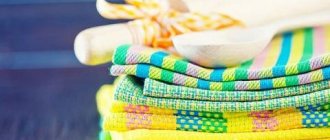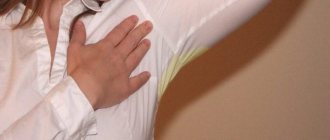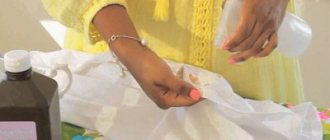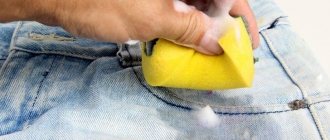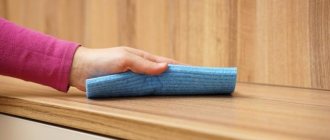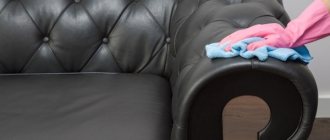Colored sweat indicates changes in the human body. The release of yellow sweat indicates the development of chromohidrosis. This manifestation is not dangerous to health, but can bring quite a lot of trouble to a person.
In a healthy person, the discharge is transparent, and yellow staining of sweat signals unfavorable changes in the human body. This is often due to changes in the functioning of the sweat glands. The problem of easily dyeing clothes in the armpit area in a different shade occurs quite often. If your sweating becomes a pronounced orange color, you should consult a specialist. To get rid of this manifestation, you should find out why chromohidrosis occurred. Sometimes the doctor suggests surgery to destroy the glands. This helps get rid of the problem forever.
Causes of excessive sweating
The disease is quite common among sweat gland problems. Sometimes accompanied by chromohidrosis. In some cases, the fluid coming out of the glands acquires a foul odor. This indicates the development of osmidrosis, which occurs due to the proliferation of fungi and bacteria.
Characteristic places of manifestation of local hyperhidrosis
Hyperhidrosis is bouts of intense sweating. Young girls under 30 years of age are more susceptible to it. Often the disease is not given much importance and treatment is not sought.
Sometimes hyperhidrosis becomes chronic. There are no clear factors for the occurrence of the disease. Often the predisposition to increased sweating is genetic.
There are several reasons for the development of the disease:
- a large number of eccrine sweat glands;
- strong reaction of the nervous system to external stimuli;
- increased sensitivity to adrenaline.
The disease is often accompanied by sleep disturbances, dizziness, and fainting. Hyperhidrosis often occurs during menopause in women, when hot flashes may occur several times a day. Excessive sweating is a sign of abnormalities in the thyroid gland. Separations can occur in diabetes after administration of a dose of insulin, pancreatitis, hypoglycemia.
Respiratory viral diseases are also often accompanied by bouts of sweating. Cystic fibrosis, tuberculosis, malaria are diseases in which discharge occurs in large quantities.
Why is it so difficult to remove sweat stains from clothes?
Sweating is a continuous physiological process that helps maintain the body’s water-salt balance. Metabolic products secreted by the sebaceous glands enter a warm environment and provoke the proliferation of bacteria.
Untimely treatment of the armpits leads to tissue erosion. In the future, such stains grow, acquiring a specific smell, and staining clothes a poisonous yellow color.
Proteins and fatty secretions attached to sweat make it difficult to remove sweat stains, and bacteria under the influence of heat treatment cause them to darken. Typically, these problems are observed in the armpit area.
Regular washing, which easily removes the characteristic smell of sweat from clothes, will not be able to cope with yellow stains ingrained into the fabric. Therefore, to solve this problem you need to resort to some secrets and recommendations.
Methods for diagnosing causes
In the case of yellow sweat, visual diagnosis does not give any result. The doctor can only assess the intensity of the staining, but to clarify the reasons, additional examination is necessary.
Most often, fluorescent diagnostics are performed using a Wood's lamp. The device emits light in the ultraviolet range, so the procedure itself is painless for patients. Colonies of various bacteria and fungi in the rays of this spectrum appear as spots of different colors, hence the name of the method. Luminescent diagnostics is the fastest method for identifying pathologies on the skin.
Additionally, the patient may be referred to:
- submitting scrapings for microscopic examination;
- bacteriological examination;
- general and biochemical blood tests.
Based on the examination results, the doctor can make an accurate diagnosis and understand what treatment tactics to choose for the patient.
Features of removing sweat stains from clothes
Stains caused by sweating must be removed as soon as possible.
Important! As a result of repeated washing and contact with hot water, sweat stains become permanent and difficult to remove.
How to remove light shades from things?
Yellow sweat stains are quite difficult to remove from light or white clothes without resorting to additional products. According to reviews from experienced housewives, in this case it is worth using several proven methods. Namely:
- Laundry soap - rub the stains with a bar and leave in this position for 1 hour.
- Laundry soap and boiling (the method is applicable to cotton fabrics that can withstand high temperatures). Grate a bar of soap on a coarse grater, soak the product in a metal container and add soap shavings to it. Boil for 40 minutes, stirring occasionally.
- Bleach (Persol, etc.) – dissolve 1 tsp. product in 250 ml of water, apply to the problem area, leave for 2-3 hours, and then rinse.
- Vodka or vinegar solution (9%). Treat the problem area with vinegar or vodka diluted with water (1:1).
- Fairy – dilute 1 tsp. product in a glass of water, apply to sweat stains and leave for 2 hours.
- Baking soda - dissolve 4 tbsp. l. soda powder in 1/4 tbsp. water, apply to the contaminated area and leave for 2-3 hours so that the solution penetrates as deeply as possible into the structure of the fibers.
A few more ways:
- Salt (recommended for cleaning natural fabrics) – dissolve 1 tbsp. l. salt in a glass of water, apply to the stained area and leave for 2 hours.
- Salt and ammonia - 1 tbsp. l. Dissolve each component in a glass of water. Apply the resulting mixture to the problem area, lightly rub with a brush and leave for 1 hour.
- Aspirin - dilute 2 tablets of the drug in 1/2 tbsp. water. Treat sweat stains with the solution and leave for 3 hours. Wash the item. If you can’t get rid of the dirt the first time, repeat the procedure. In this case, only a few drops of water will be needed to dilute Aspirin to form a thick paste. Apply it to the stain, leave for 1 hour, and then rinse.
- Hydrogen peroxide (recommended for minor stains) – treat the problem area with a cloth soaked in peroxide, rinse with water and dry.
Advice! After using each product listed, you must wash the product.
How to get rid of dirt from dark-colored items?
Since stains are not very noticeable on black fabric, it will be much easier to remove them and the specific smell. To do this you need to use one of the following methods:
- Laundry soap - soak the product in slightly warm water, soap the contaminated area, leave for 30 minutes, then wash.
- Salt (recommended for processing silk clothing) – dissolve 1 tsp. salt in 250 ml of water. Pre-soak the item in warm water with washing powder and leave for 1 hour. Apply the saline solution to contaminated areas, wait 15 minutes, and then rinse.
- Salt in combination with ammonia (the product is recommended for cotton and linen products) - dilute 1 tbsp in 250 ml of water. l. each component. Apply the mixture to the contaminated area and leave for 20 minutes.
Have you ever removed yellow sweat stains from clothes?
Not really
How to deal with old stains?
Sweat stains that have become embedded in the fabric are difficult to remove. First of all, you need to soak the product with soap, powder or bleach. Then wash and rinse thoroughly. Having completed these manipulations, you can resort to the help of active substances.
The most effective methods for removing old sweat stains are the following:
- Lemon juice and ammonia - soak the product in a vinegar solution (2 tablespoons/5 liters of water) and leave for 30 minutes. Dilute in ½ tbsp. warm water 1 tbsp. l. ammonia. Apply the resulting solution to problem areas, leave for 10 minutes and rinse. Prepare the composition by diluting 1 tbsp. l. lemon juice with 1/2 glass of water. Moisten areas with sweat stains generously in it and leave for 2 hours.
- Vinegar and soda - dissolve 2 tbsp. l. vinegar in 5 liters of water, and soak clothes with sweat stains in this mixture. Dilute 4 tbsp. l. soda in 250 ml of water. Treat problem areas with the resulting solution and leave for 2-3 hours.
- Aspirin and laundry soap - dissolve 2 tablets in ½ tbsp. cold water. Apply the solution to the problem area and gently brush with a brush. Wait 3 hours, then wash the product with laundry soap, thoroughly rubbing it into the yellow stains. Repeat washing as usual.
- Vodka – generously moisten a cotton pad or dry cloth with vodka or alcohol diluted with water in a 1:1 ratio. Wipe the dirty area. If the stains do not disappear, repeat the manipulations and put the item aside for 2-3 hours. After this time, wash as usual.
Attention! When choosing the most suitable method, it is necessary to take into account the characteristics of the fabric being processed and its shade.
Treatment
The treatment method for yellow sweat depends on the cause that caused the development of this pathology:
- Elimination of the main type of disease that caused the appearance of sweat with a characteristic yellow color,
- Elimination of harmful conditions when working in chemical production or directly living in poor environmental conditions.
If there are clear indications, doctors can undertake radical treatment methods:
- Ultrasonic destruction of sweat glands,
- Removal using liposuction or endoscopic curettage,
- Complete excision of the area on the skin in which abnormally increased sweating is localized.
These procedures can cause additional complications in the body, which are associated with the appearance of new areas on the body with the manifestation of hyperhidrosis and require additional physiotherapeutic procedures.
One of the innovative methods in the fight against profuse sweating is Botox injections, which stop the active work of the sweat glands. However, these procedures give a short-term effect and need to be repeated after 8–10 months.
What is prohibited to use?
When choosing the appropriate method for removing sweat stains, you must remember that some of them can have negative consequences.
Chlorine
Chlorine-containing preparations are prohibited for use when cleaning both colored and white products. This is due to the ability of chlorine to enter into a chemical reaction with proteins included in the structure of sweat. As a result, the fabric fibers darken and soiling becomes more pronounced.
Heat
Exposing sweat stains to high temperatures helps to fix them and enhance the specific odor. The recommended temperature for washing clothes with such contaminants should not exceed 30 °C. In addition, washed items should not be dried on a radiator.
Intense mechanical impact
In order not to cause harm to the structure of the fabric, it is important to avoid strong friction during the cleaning process. When dealing with sweat stains on silk products, it is prohibited to use acetic acid and acetone.
Popular myths
Yellow sweat causes concern among people who are far from medicine, so the phenomenon is constantly surrounded by speculation. We will try to refute the most popular of them.
Yellow sweat is life-threatening
If the sweat does not smell like urine, there is no threat to life. The exception is signs of jaundice. In this case, you should not think about whether you need a doctor, but visit the nearest medical facility and make an appointment.
If during the examination it turns out that yellow sweat appeared due to an increase in the concentration of bilirubin, it is possible that we are talking about functional changes in the liver. You cannot hope for a miraculous healing and try to disguise the non-standard color of sweat.
Disease can be identified by color
Apart from the cases listed above, the color of sweat is in no way related to the pathological processes occurring in the body. It is impossible to predict what kind of disorder will appear in the body in the future by assessing only the color of sweat and the degree of its intensity.
Doctors are hiding a cure for yellow sweat
Medicine is not omnipotent, so the statement that doctors hide effective treatment methods is devoid of common sense. The functions of apocrine glands that influence the color of sweat are poorly understood. This means that pharmacists cannot select a remedy that can influence this cause of the problem.
It is only known that antiperspirants, including medical ones, can suppress secretion in the apocrine glands. But such exposure leads to the development of hidradenitis - purulent inflammation of the glands. For this reason, the use of antiperspirants for the treatment of yellow sweat is not considered.
For your information. Also, traditional methods, various tablets and injections are powerless against the problem.
Yellow sweat is bad for your health
In most cases, changes in the color of sweat do not directly affect the functions of the body's systems. However, an indirect influence cannot be ruled out. For most people, sweat of a non-standard color is a source of psychological problems and worries, which, in turn, is fraught with the development of pathologies in the body:
- formation of stomach ulcers with existing gastritis;
- development of neuroses;
- the appearance of insomnia;
- headaches and other problems.
Professional stain removers
Industrial stain removal products allow you to quickly get the desired result.
Amway Pre Wash
The product allows you to remove not only traces of sweat from clothes, but also stains of paint and even ink. Its main advantage is that there is no need for pre-soaking and washing.
Frau Schmidt
The stain remover is available in the form of soap: bar or liquid. It is recommended for removing stains on items made from natural fabrics, satin, silk and wool. Processing of colored items is acceptable.
Ecover
The stain remover is environmentally friendly. The natural herbal ingredients that make up Ecover allow it to be used not only to remove traces of sweat, but also to wash children's clothes.
Vanish Oxi Action
The product effectively removes even the most stubborn stains. In addition, it returns the original whiteness to items that have turned gray from time and numerous washes. To achieve the desired result, just soak the clothes in water with one scoop of Vanish Oxi Action diluted.
This article will tell you how to clean a sofa without streaks with Vanish at home.
Udalix Ultra
The drug is presented by the manufacturer in two versions:
- powder;
- pencil for local application.
Intended for use for cleaning stains from all types of fabrics with any colors.
Antipyatin
Antipyatin is an effective alternative to laundry soap. The product is available in the form of powder, gel, foam and soap. The active oxygen contained in it quickly removes contaminants and returns the lost whiteness to the product.
Antipyatin allows you to easily remove old stains and specific odors that have become ingrained into the fabric fiber structure.
Rules of use:
- Moisten problem areas of clothing generously with slightly warm water.
- Lather well.
- Leave for 30 minutes.
- Rinse and then wash as normal.
If necessary, repeat the procedure until the stains completely disappear.
Important! Despite the fact that Antipyatin is suitable for all types of fabrics, it is recommended to test it on the wrong side.
Faberlic Edelstar
The product is a pencil for removing dirt. The procedure for whitening the armpit area on clothes using this stick includes the following steps:
- treat the problem area;
- put the item aside for 20 minutes;
- wash in the traditional way.
Sarma Active
The stain remover has several advantages:
- affordable price;
- ability to remove contaminants deeply penetrated into fiber structures.
Clothes treated with Sarma Active are left for several hours and then washed.
Effective prevention measures
Following a number of rules will help reduce the likelihood of yellowing of armpits on clothing:
- shower procedures using high-quality body cosmetics help eliminate plaque on the skin of the axillary area in the form of sweat and residues of deodorizing compounds;
- You should dress for the weather to reduce the activity of your sweat glands. It is worth considering that the sweating organs are a tool for thermoregulation of the body, ensuring the temperature balance of the body;
- Limiting the intake of spicy foods, including sauces with red pepper and fresh garlic, horseradish-based seasonings and mustard, will help reduce the intensity of sweat. Hot food and abuse of strong drinks also enhance the work of sweat secretions;
- It is worth remembering that increased levels of sweating are observed in a number of ailments, including infectious diseases. The work of the sweat glands is also noticeably activated during stressful situations and emotional stress;
- It is not recommended to frequently use antiperspirants, since the compositions tend to block the pores of the epidermis. This causes dysfunction of the sweating organs.
According to experts in the field of physiology and dermatology, the best way to prevent increased activity of sweat glands is a healthy lifestyle and compliance with basic rules of personal hygiene.
Since old marks on the armpits of clothes are washed out with great effort, yellowness should be removed immediately, without delay. When choosing a stain remover, you need to take into account the composition of the fabric, recommendations on the product label and use the products according to the manufacturer’s instructions.
How to prevent sweat stains?
A few simple rules will help you avoid the formation of sweat stains:
- If possible, use the thinnest possible underwear that absorbs moisture and prevents the appearance of visible stains.
- Use special underarm inserts.
- Change and wash clothes as often as possible (especially on hot days).
Advice! A fairly effective remedy for wet armpits is baby powder. To do this, problem areas are thickly covered with it, after which they are carefully ironed.
Under the influence of high temperature, the powder is imprinted into the fabric, creating a barrier against moisture and bacteria - the causes of unpleasant odors. Baby powder also prevents yellow spots.
There are many ways to help get rid of yellow stains in the armpits. In order to quickly get an effective result and not spoil the clothes, it is important to choose the most suitable product for a particular fabric and strictly follow the recommendations specified in the recipe.
Precautionary measures
When dealing with yellow stains under the arms, you need to remember the composition of the fabric and follow simple rules:
- Carefully read the composition and method of use of the stain remover
- If in doubt when choosing, use a product with active oxygen
- Do not use prohibited mixtures
- Frequent use of chlorine-containing compounds quickly wears out laundry
All recommendations for caring for the product are indicated on the label sewn on the back side. If the label is lost, or if you have any doubts, you can test the solution used on an invisible area of the product (the inside of the pocket, the back of the hem, or the cuff).
Caring for colored items
You need to be more careful with colored fabrics. To eliminate yellow spots under the arms, you should carefully study the composition of stain removers and do not use bleaches. Most effective:
- use a composition containing oxygen and enzyme
- remove fresh stains with table salt diluted in water to a paste with shavings of laundry soap
- mix 10 g of denatured alcohol with egg yolk and apply to old sweat and grease stains, keep until completely dry, wash only in cool water
- aspirin plus peroxide will save you from the most difficult traces of sweat
There can be much more problems with colored clothes than with white ones, due to possible loss of color. The main rule remains - wash in cool water.
Blue color
Blue sweat usually occurs when ferrous oxide phosphate enters the body. Do not put off visiting the clinic. Specialists will offer to undergo a full examination, which includes:
- blood analysis;
- cardiogram;
- Analysis of urine;
- Ultrasound of internal organs;
- sweat analysis.
It is recommended to investigate the source of drinking water, which may contain substances that color sweat. If the reason is water, then the doctor will suggest a colon cleanse. The coloring indicator enters the blood from this organ.
Blue sweat may also indicate possible problems with the gastrointestinal tract. It is recommended to visit a gastroenterologist to rule out diseases of the internal organs. The presence of a number of chemical elements can contribute to the coloration of sweat fluid. Such substances include:
- ferrous oxide;
- indigo;
- pyocionide;
- phosphate.
Based on the test results, a specialist will be able to determine why the sweat is blue.
White color
The natural shade of human sweat is colorless. But often the sweat fluid changes color. The causes of white sweat are the presence of a large amount of salts in the discharge. This is not a serious pathology, but it leads to the appearance of complexes in humans. White spots on clothes do not look aesthetically pleasing. It is recommended to discuss with a specialist why the sweat is white.
Symptoms
The manifestation of the disease can be noticed by paying attention to the initial signals of one’s own body. Chromidrosis in almost every case is accompanied by hyperhidrosis - an increased process of sweating even under natural normal conditions of the surrounding world. If a person sweats indoors as if he were on the beach, then this condition can be considered hyperhidrosis.
The minimal presence of colored impurities during sweating is the initial symptomatology of this disease. But it is necessary to distinguish the true form of the disease from the false one. Sometimes sweat takes on a certain color due to interaction with low-quality clothing fabric.
With the true nature of the disease, staining occurs due to the excessive proliferation of microflora, which may be accompanied by other symptoms. Chromidrosis often acts as a concomitant symptom of another disease, less often it is isolated as a separate disease.
